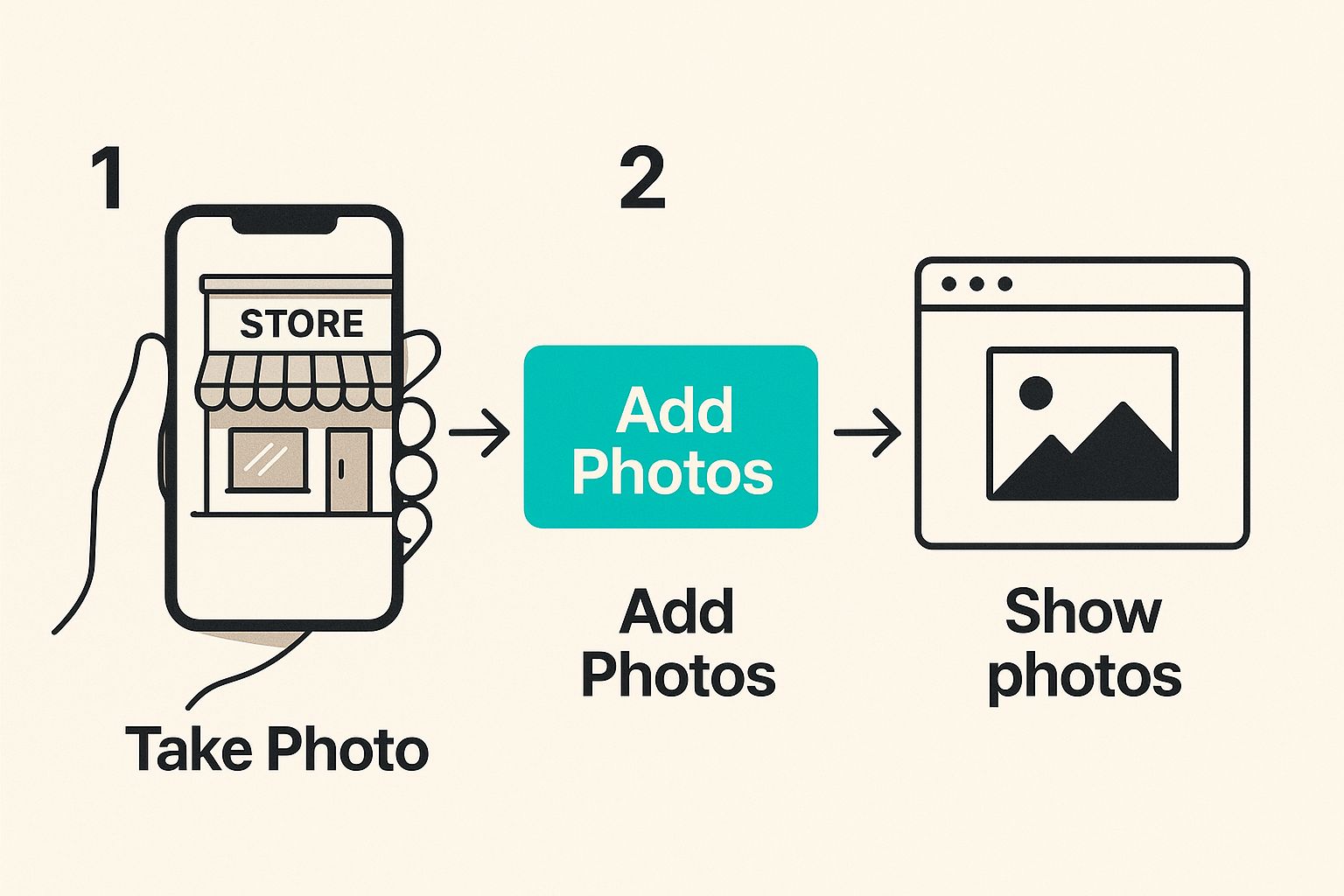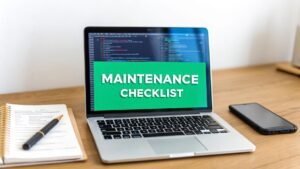To really get the most out of your Google Business Profile, you need to treat it like a living, breathing part of your business. This means filling out every single section with meticulous detail, uploading fresh, high-quality photos every week, and making a habit of gathering and responding to customer reviews. These aren't just busywork tasks; they're strong signals to Google that your business is relevant, active, and trustworthy—all critical for climbing the local search rankings.
Your GBP Is Your Digital Front Door

It’s time to stop thinking of your Google Business Profile as just another line item in an online directory. In reality, it’s the most powerful free tool you have for winning over local customers right when they’re looking for you.
Simply having a profile isn't the goal. It's about building a profile so compelling that it stops a searcher in their tracks and turns them into a customer. A fully fleshed-out profile builds immediate trust and, more importantly, drives action.
Think about it in real-world terms. I've seen a local plumber get a 30% jump in emergency calls just by adding their 24/7 hours and showcasing a gallery of recent job photos. Or a small coffee shop that sees a weekend rush after running a simple Google Post about a new seasonal drink. This is the tangible impact we're talking about.
Why Optimization Builds Immediate Trust
Letting your GBP collect dust isn't just a missed opportunity—it's like putting up a sign that says, "Go check out my competitor." When your profile is sparse, you look less credible and established than the business next door whose profile is humming with activity.
The data doesn't lie. Research shows that customers are 2.7 times more likely to trust a business with a complete, well-managed Google Business Profile. If you're serious about your local presence, it's worth digging into the nuances of unlocking the full potential of an optimized Google My Business profile.
A complete profile is more than just your business name. It's the nitty-gritty details: accurate contact info, precise business hours, and a comprehensive list of every service you offer. Keeping this information fresh and encouraging a steady stream of authentic customer reviews is what convinces potential customers to pick up the phone, click to your website, or walk through your door.
Here's the bottom line: A neglected profile quietly suggests a business that doesn't care about the details. On the flip side, a profile rich with recent photos, an active Q&A section, and thoughtful replies to reviews tells customers you’re engaged, professional, and ready for their business.
The Core Pillars of a Winning GBP
To build a profile that genuinely works for you, you need to focus on a few essential components. Each pillar supports the others, creating a powerful, trustworthy, and high-ranking local presence that pulls in new customers.
Think of it as building a house. You can't put up the walls without a solid foundation first.
| Optimization Pillar | Key Action | Impact on Customers & SEO |
|---|---|---|
| Complete & Accurate Information | Fill out every field: NAP, hours, services, and attributes. Ensure 100% consistency across the web. | This is the foundation of trust. It tells Google and customers you're a legitimate, operating business. |
| Visual Engagement | Regularly upload high-quality photos & videos of your storefront, team, work, and happy customers. | People buy with their eyes. Visuals build an emotional connection and show proof of your quality. |
| Social Proof & Interaction | Actively request reviews and respond to every single one—good, bad, or indifferent. | Reviews are modern word-of-mouth. Engaging with them shows you care and builds immense credibility. |
| Timely Updates & Freshness | Use Google Posts weekly for offers, news, or updates. Keep your Q&A section current. | This signals to Google that you're an active business, keeping you top-of-mind and your profile relevant. |
By consistently working on these four areas, you're not just getting listed on Google—you're actively competing for local attention and proving you're the best choice in town.
Getting the Foundation Right

Before we get into the more exciting stuff like photos and posts, we have to talk about the fundamentals. Think of it like building a house—if the foundation is shaky, everything you build on top of it is at risk of collapsing. These core details are what both Google's algorithm and your potential customers depend on for accuracy and trust.
The single most important piece of this foundation is your NAP consistency. That’s your business Name, Address, and Phone number. These three pieces of information must be a perfect, character-for-character match everywhere they show up online. I'm talking about your website, social media, Yelp, and any other directory you can think of.
Even a tiny discrepancy, like using "St." on your GBP but "Street" on your website, can create enough confusion to hurt you. To Google, that inconsistency is a red flag, signaling that you might not be a credible, stable business.
The Real Cost of Getting It Wrong
I once worked with a local bakery that was tearing their hair out. They had just moved to a beautiful, larger location across town, but their Google Business Profile rankings were in a freefall.
The culprit? They had forgotten to update their address on a few old, obscure online directories from years ago. Google’s crawlers were finding conflicting information. That doubt was enough for the algorithm to drop their authority and start ranking their competitors higher. It took weeks of painstakingly hunting down and correcting every last listing, but once they did, their visibility on Google Maps bounced right back.
Your business name, address, and phone number are the absolute cornerstones of your online identity. Keeping them perfectly consistent isn't just a "best practice"—it's a non-negotiable requirement for earning Google's trust and claiming your spot in local search.
Choosing Your Categories Is a Strategic Move
Picking your business category might seem simple, but it has a massive impact on your visibility. Your primary category is the most crucial choice you'll make here, as it dictates your core identity to Google and unlocks specific features relevant to your industry.
Here's where a little strategy goes a long way. Let's say you run a pizza joint that also serves amazing pasta and salads. Choosing "Pizzeria" as your primary category is infinitely more powerful than the generic "Restaurant." You're telling Google exactly what your main draw is, targeting customers with a very specific craving.
- Primary Category: This needs to be your specialty. Always go for the most specific option available. "Nail Salon" will serve you better than the broader "Beauty Salon."
- Secondary Categories: Use these to capture all your other services. For our pizzeria, adding "Italian Restaurant" or "Salad Shop" helps you show up for people looking for more than just a slice.
Remember, a staggering 84% of profile views come from discovery searches (think "pizza near me"), not from people searching your business name directly. Your category choices are your first and best chance to get in front of them.
Writing a Business Description That Connects
Next up is your "from the business" description. Google gives you 750 characters to make your case, so every word counts. This isn't just a spot for keyword stuffing; it's your elevator pitch to a potential customer.
The first 250 characters are prime real estate, as they appear in the search results before a user has to click "more." Use this space to immediately communicate what makes you different.
- Don't state the obvious: Your address and hours are already listed elsewhere on the profile. Use this space for your unique value.
- Tell your story: Are you a family-owned business that's been around for 50 years? Say that. Do you source all your ingredients locally? Highlight it.
- Weave in keywords naturally: Of course, you want to include terms people search for, but make it sound like a real person wrote it.
A compelling description can be the difference between a user scrolling past and one who decides to dig deeper into your profile. If you're looking for help tying all these elements into a bigger picture, our SEO services can help craft a cohesive strategy that goes beyond just your GBP.
Use Attributes to Stand Out from the Crowd
Finally, don't sleep on Attributes. These are the little checkboxes and tags that let you highlight specific features of your business. Google provides a list based on your category, and you should go through and select every single one that applies.
These aren't just minor details. Think about how a potential customer searches:
- "Wheelchair accessible entrance"
- "Online appointments"
- "Outdoor seating"
- "Women-led"
For a customer who is specifically looking for a "cafe with outdoor seating," having that attribute checked could be the single deciding factor that sends them to your door instead of your competitor's. It's a simple way to win over highly motivated customers.
If your core business information is the black-and-white blueprint, then your photos and videos are what bring it to life in full, living color. It's one thing to read about a business, but it's another thing entirely to see it.
High-quality visuals are what stop a potential customer mid-scroll. They build an emotional connection and make people feel like they've already walked through your door. This is how you transform from just another name on a map into a real, tangible place someone actually wants to visit.
And the data backs this up. According to Google, businesses that feature photos on their profiles get a staggering 42% more requests for driving directions. On top of that, they see 35% more clicks through to their websites compared to businesses without them. The impact is undeniable.
Your Visual Content Playbook
Just uploading your logo and a single storefront picture isn’t going to cut it. That's the bare minimum. To really get ahead, you need a consistent visual strategy—think of it as a simple content plan for your profile to keep it fresh, active, and engaging.
A great place to start is uploading at least one new photo every single week. This steady stream of activity sends a powerful signal to Google that your business is active and relevant, which is a nice little boost for your local rankings.
Don't overthink it. Here’s a simple weekly schedule you can steal:
- Team Tuesdays: Post a candid shot of your team at work. This puts a human face to your brand and builds a layer of trust that text alone can't.
- Work-in-Progress Wednesdays: Give people a peek behind the curtain. If you run a bakery, show some dough rising. For a contractor, a mid-renovation shot is perfect. It builds anticipation.
- Product/Service Fridays: Time to show off. Highlight a specific product or service in detail. Capture your best-selling dish, a freshly detailed car, or a featured item in your shop.
- Storefront Saturdays: Snap a fresh, inviting picture of your business exterior. This works especially well if you've decorated for a season or the weather is just too nice to ignore.
This isn't complicated. As you can see below, building out your visual library can be done right from your phone in just a few minutes.

The key takeaway here is simple: adding photos is a small action with a huge impact. You’re turning your physical location into a dynamic digital asset.
And don't just stop at static photos. Never underestimate the power of a short video. A quick, 30-second walkthrough of your shop filmed on your phone or a clip of a product in action can be far more compelling than a dozen polished pictures. It offers an authentic, unscripted glimpse into your business that customers really connect with.
Turning Google Posts into Free Local Ads
Now, let's talk about one of the most powerful—and most overlooked—features for optimizing your profile: Google Posts.
Think of Posts as free, hyper-local ads that show up directly on your Business Profile in search results and on Google Maps. They are absolutely perfect for grabbing attention and driving immediate action.
Posts are temporary, usually lasting for seven days (event posts are the exception), which makes them ideal for timely promotions and updates. More importantly, using them consistently is a major ranking signal for Google.
By not using Google Posts, you are missing out on free advertising space at the exact moment a potential customer is looking for you. It's the digital equivalent of having a blank billboard right outside your front door.
Crafting Posts That Convert
There are a few different types of posts you can create, and each one serves a specific purpose. Once you get the hang of them, you can run targeted mini-campaigns right from your GBP dashboard.
What's New Posts
These are your bread-and-butter updates. Use them to announce a new blog article, share a fantastic customer testimonial, or show off a recently completed project. The goal is to keep your audience in the loop and prove your business is always active.
- Example for a Landscaper: "Just wrapped up this beautiful patio installation in the Colonial Heights neighborhood! We love how the stone pavers complement the garden beds. See more of our work on our website." (CTA: Learn More)
Offer Posts
This is where you drive sales. Create a compelling offer with a clear start and end date to build a sense of urgency. You can even include coupon codes, links to your sales pages, and any terms and conditions.
- Example for a Coffee Shop: "Get 20% off any large espresso drink this week! Just show this post at the counter to redeem. Perfect for beating that afternoon slump." (CTA: Redeem Offer)
Event Posts
Got something happening on a specific date? This is the post type for you. Promote anything from a webinar or an in-store workshop to a live music night or a holiday sale. It puts your event right in front of an interested local audience.
- Example for a Bookstore: "Join us for our monthly author reading this Saturday at 7 PM! Local author Jane Doe will be reading from her new novel. Free admission and refreshments provided." (CTA: RSVP)
No matter what type of post you create, always include a high-quality image or video, a short and punchy description (the first 100 characters are what people see first), and a crystal-clear call to action (CTA). When you treat visuals and Posts as essential parts of your strategy, you transform your profile from a static listing into an active, engaging tool that brings customers through your door.
Diving into Reviews and Customer Q&A
Think of social proof as the new word-of-mouth. On your Google Business Profile, nothing is more valuable than your reviews and the questions people ask. These aren't just passive bits of feedback; they're powerful signals to Google and huge trust-builders that directly shape whether a customer picks you over the competition. A steady flow of authentic reviews tells Google you're a legitimate, active, and respected business.
The data absolutely backs this up. An in-depth analysis of over 2 million Google Business Profiles found a rock-solid link between the number of reviews and search ranking. Businesses that land in the top three local search spots average around 250 Google reviews. In contrast, those ranked lower typically have fewer than 200. The research is clear: a solid review strategy is non-negotiable for top-tier visibility. You can dig into the full study on how reviews influence local rankings for more details.
This connection makes it obvious why actively managing this part of your profile is a core task for anyone serious about local SEO.
Building a System for Consistent Reviews
The most effective way to get reviews is also the simplest: just ask. I know a lot of business owners feel awkward about this, but a staggering 62% of customers will happily leave a review if you just make the request. The trick is to make the process completely seamless.
A simple, incredibly effective strategy is to send a follow-up message—either via email or text—a day or two after a great customer interaction.
Here’s a template you can tweak and make your own:
- Email/Text Template: "Hi [Customer Name], thank you for choosing [Your Business Name]! We hope you had a great experience. If you have a moment, we'd be incredibly grateful if you could share your feedback on Google. It helps others in our community find us. Here's a direct link: [Your Google Review Link]."
This approach is polite, direct, and, most importantly, provides the link, which removes all the friction for the customer.
Pro Tip: Whatever you do, never offer discounts or gifts in exchange for reviews. This is a direct violation of Google's policies and can get your profile penalized. The goal is to earn authentic feedback, not buy it. Genuine reviews, even the ones that aren't five stars, build far more trust in the long run.
The Art of Responding to Every Single Review
Getting reviews is just step one. The real magic happens when you respond. Replying to every single review—good, bad, or just okay—shows potential customers you're engaged and that you genuinely care. It goes beyond just managing reviews; understanding the broader concept of customer experience is fundamental to managing your online reputation and driving real business growth.
Responding to a Positive Review
When someone leaves a glowing review, don't just drop a "Thanks!" and move on. Use it as a chance to reinforce what makes your business great and sprinkle in some relevant keywords.
- Example Positive Response: "Thank you so much for the kind words, Sarah! We're thrilled you enjoyed our signature lavender latte and the cozy atmosphere at our downtown Johnson City cafe. We look forward to seeing you again soon!"
This reply feels warm and personal, but it also strategically includes keywords like "signature lavender latte," "cozy atmosphere," and the location "downtown Johnson City cafe." Little details like this can help your profile show up in more specific, high-intent searches.
Handling a Negative Review with Grace
A negative review can feel like a punch to the gut, but it’s actually a golden opportunity. A thoughtful, professional response can win over the next customer who is watching to see how you handle criticism.
- Acknowledge and Apologize: Start by acknowledging their frustration. Offer a sincere apology, even if you feel their assessment is unfair.
- Take it Offline: Provide a direct line of contact, like an email or phone number, to resolve the issue privately. This shows you're proactive and serious about making it right.
- Stay Professional: Never, ever get into a public argument. Remember, your response is for every future customer, not just the unhappy one.
- Example Negative Response: "Hi Mark, thank you for taking the time to leave this feedback. We're very sorry to hear that your experience didn't meet your expectations. Providing excellent service is our top priority, and it's clear we missed the mark here. Please contact our manager at [email/phone] so we can learn more and work to make things right."
Actively Manage Your Q&A Section
Finally, don't sleep on the Questions & Answers section. This feature is chronically underused, but it's a prime piece of real estate to control the narrative and tackle common sales objections before they even become an issue.
Since anyone can ask and answer questions on your profile, you have to be proactive.
- Seed Your Own FAQs: Think about the questions you get all the time—about parking, pricing, specific services, or booking policies. Post them yourself!
- Provide Official Answers: Immediately answer your own questions with clear, helpful, and keyword-rich information. This establishes the correct information from the start.
- Monitor for New Questions: Make sure you have alerts set up. When a new customer question comes in, you want to be the first one there with a swift, accurate, and official answer.
When you master your reviews and Q&A, you're doing more than just checking boxes on your profile. You’re building a dynamic, trustworthy, and engaging presence that turns casual searchers into loyal customers.
Turning Performance Data Into Action
Optimizing your Google Business Profile is a great first step, but how do you actually know if all that hard work is paying off? The answer is tucked away inside your Performance report. This isn't just a spreadsheet full of numbers; it’s a story about how real customers find and engage with you. Learning to read that story is your secret weapon.
Too many business owners get hung up on what I call "vanity metrics." Sure, seeing a huge number of impressions feels good, but it tells you almost nothing about your return on investment. The real gold is in understanding what actions those eyeballs took next. To make smart, data-backed decisions that actually grow your business, you have to move past simple view counts.
Decoding How Customers Find You
Your performance report splits your search traffic into two main buckets: Direct and Discovery.
- Direct Searches: These are the people who already know you. They typed your business name or address straight into Google, like "Swish Web Designs Tri-Cities."
- Discovery Searches: This is the exciting one. These users searched for a service, product, or category you offer, and your profile popped up. Think "web design Johnson City" or "local SEO services near me."
A high number of Discovery searches is a massive win. It’s hard proof that your optimization efforts—getting the right categories, services, and keywords dialed in—are working. You’re successfully capturing brand-new customers who had no idea you existed moments before they searched.
When your Discovery searches start to climb and eventually tower over your Direct searches, that’s a crystal-clear sign your local SEO strategy is hitting the mark. You're reaching people who are actively looking for the very solutions you provide.
Reading the Story Behind the Numbers
The key is to look at how different metrics connect. For example, what if you see a huge spike in requests for directions but almost no website clicks? That might tell you your photos and five-star reviews are compelling enough to make people want to visit you in person, but your service descriptions or calls-to-action in your Google Posts are falling flat.
This is where you can start connecting your specific actions to real-world results. Did you upload new photos of a finished project last week? Jump into your report and see if photo views and direction requests ticked up. Did you run a special offer in a Google Post? Look for a matching bump in website clicks or phone calls.
By drawing these lines, you can measure the true impact of your optimizations and pour your energy into what’s actually moving the needle. This performance data is what teaches you precisely how to rank higher on Google Maps because it shows you exactly what your potential customers are responding to.
On average, a well-managed GBP pulls in around 200 clicks every month. This usually breaks down into about 105 website visits, 66 direction requests, and 50 calls. These profiles also tend to generate roughly 1,800 monthly impressions, with a staggering 84% of them coming from discovery searches. But here’s the opportunity: only 40% of businesses even break the 1,000 monthly impression mark. This leaves a massive opening for fully optimized profiles to completely dominate the local search results. For a deeper dive into these benchmarks, you can explore detailed GBP statistics on searchendurance.com.
A Few Common Google Business Profile Questions
Even with a detailed guide, you'll always bump into practical questions once you start digging into your Google Business Profile. Let's tackle some of the most common hurdles and real-world queries we hear from business owners. Here are some quick, actionable answers to help you navigate the finer points.
How Often Should I Actually Update My Profile?
This is a fantastic question because, with Google, consistency is far more important than intensity. You don’t need to be in there every single day overhauling things, but a great rule of thumb is to aim for at least one small update per week.
This weekly activity doesn't mean you have to change your business hours or core info. It's more about sending a signal to Google that your profile is active and offers fresh value to searchers. These small, consistent updates show you're engaged and that your information is current, which can absolutely have a positive effect on your local rankings over time.
Think of it like tending a garden. A little bit of regular attention keeps it healthy and thriving.
- A Few Simple Weekly Tasks:
- Upload a new, relevant photo—your team in action, a recently completed project, or even just your decorated storefront.
- Publish a quick Google Post about a weekly special, a recent customer success story, or a helpful industry tip.
- Jump in and promptly respond to any new reviews that have come in.
- Answer a new question in the Q&A section (or even add a common question yourself and answer it).
What If I'm a Service-Area Business Without a Physical Address?
This is a classic scenario for plumbers, mobile dog groomers, landscapers, and consultants who visit customers at their locations. The single most critical step here is to hide your physical address during the setup process. Never, ever display your home address; it’s a direct violation of Google's terms and a fast track to getting your profile suspended.
When you do this correctly, your profile will show a shaded region representing your service area instead of a map pin.
For a service-area business, your optimization focus shifts. You're no longer trying to rank a pin on a map. Instead, your goal is to prove your expertise and activity within your defined territories, showing Google you're the relevant choice for customers in those specific towns or neighborhoods.
Your strategy needs to double down on all the other powerful elements of your profile:
- Be specific with your services. List every single service you offer with detailed descriptions.
- Lean heavily into photos. Upload tons of pictures of your work out in the field, your branded company vehicles, and your team on the job.
- Actively chase reviews. When you respond to a happy customer, mention the city or neighborhood where you did the work (e.g., "Thanks for the great feedback on the HVAC installation in Johnson City! We appreciate your business.").
- Use Google Posts strategically. Highlight projects you've recently completed in different parts of your service area to show your geographic reach.
Can I Put Keywords in My Business Name?
Let me be crystal clear on this one: absolutely not.
Adding keywords or location names to your business title—something like "Bob's Plumbing – Best Plumber in Johnson City"—is a practice called "keyword stuffing." It's a direct and blatant violation of Google's guidelines.
Your business name on your profile must be your real-world, officially registered business name. Trying to game the system this way is a short-sighted tactic that will almost certainly lead to a swift profile suspension, wiping out all your hard work in an instant.
Instead of trying to force keywords where they don't belong, focus on weaving them into the sections where they're supposed to go. The correct—and sustainable—approach is to place them naturally within your:
- Business description
- Detailed services list
- Thoughtful responses to customer reviews
- Helpful answers in the Q&A section
What Should I Do About Fake or Malicious Reviews?
It’s incredibly frustrating to find a fake positive review on a competitor's profile or, worse, a fake negative one on your own. The only correct way to handle this is to flag the review for removal.
Click the three small dots next to the suspicious review and select "Report review." Google will ask you to choose a reason why you believe it violates their policies. Common reasons are "Conflict of interest" (if you suspect a competitor) or simply "Spam."
Now, there's no guarantee Google will remove it, but this is the official and only channel you have. Whatever you do, never engage with the fake review directly or get into a public back-and-forth. The best defense is a great offense: focus your energy on generating a steady stream of authentic, positive reviews from your real customers. A strong foundation of genuine feedback will quickly drown out the noise from a few fakes. For more strategies on managing your local presence, our local SEO checklist offers a comprehensive guide.
Are you ready to stop worrying about your website and start focusing on your business? Swish Web Designs offers a complete, hassle-free partnership, managing everything from custom design and secure hosting to local SEO that gets you noticed. Let us handle your entire online journey so you can do what you do best. https://swishwebdesigns.com


